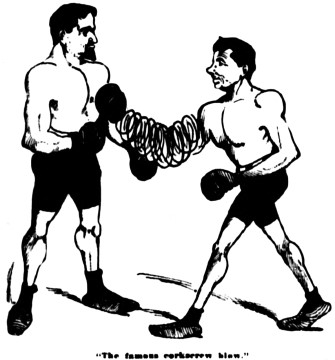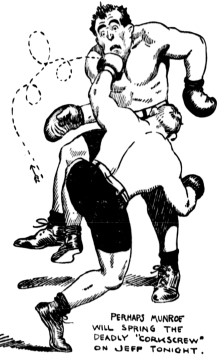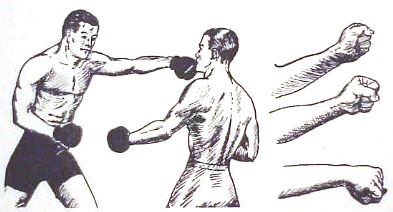 |
 The Virtual Corkscrew Museum's Weekly Newspaper |
 |
 |
 The Virtual Corkscrew Museum's Weekly Newspaper |
 |
|
Sunday, May 11, 2008 |
Number 516 |
The Corkscrew Punch
The Evening World, New York, May 20, 1902
Norman Selby was born October 13, 1872. By the age of 17 he had become a pro fighter and took on the name Charles "Kid" McCoy. He invented the "corkscrew" punch.
In 1897 McCoy won the middleweight boxing title by a knockout over Dan Creedon. He moved into the heavyweight class and was knocked out by Tom Sharkey in 1899.
McCoy not only used his famous "corkscrew" in his fights but he resorted to all kinds of screwy trickery including spreading rumors that he wasn't training or that he was injured or that he was very sick. For the latter he sprinkled talcum powder on his face to appear pale and sickly before one fight. These ploys would change the betting odds and McCoy would capitalize on them by emerging victorious in his fights.
In 1903 a new light heavyweight division was created. McCoy battled Jack Root for the title. He lost in 10 rounds. He was on a downhill slide.
By 1924 he had been married at least eight times, he had owned a tavern, he starred in some movies, and worked as a private detective. In 1924 he was convicted of manslaughter in the shooting death of a married woman, Therese Mors, who lived with him. He was sentenced to 24 years in prison. He secured an early release from prison and, in 1940 he committed suicide by overdosing on sleeping pills.
McCoy's "corkscrew" punch lived on when Muhammed Ali used a similar technique many years later and claimed he invented it.

An article entitled "McCoy's Ring Tactics are Peculiar" appeared in New York's The Evening World on January 19, 1900. The writer wrote "The 'Kid" is the most exasperating fighter imaginable. He dances around an opponent, slapping at the other's guard, feinting, and trying to worry him into an imprudent move."
Kid McCoy (The San Francisco Call photo).
On January 2, 1900, The San Francisco Call reported on Kid McCoy's New Year's Day knock-out fight with Irish Pugilist Peter Maher. The fight took place in New York and lasted five rounds. When interviewed after the fight, Kid McCoy said "Peter looked fresher than he felt when he came out this time. I fanned his face, then put in a left hook on his neck. He rushed at me, and I left hooked him on the neck again, but he bored right on me like a runaway horse and hurled me upon the ropes. As I got off I missed a left hook at his neck and banged his short ribs with a right corkscrew." McCoy got a hefty $12,000 for the fight while Maher got $4,000.

On August 26, 1902 a columnist previewed a fight between Jack Munroe and Jim Jeffries in The Evening World. The article was accompanied by several drawings one of which depicted the corkscrew punch.
The Punch

Here's how Kid McCoy delivered the punch:
Stand in ordinary boxing position, left foot forward, left fist ready to lead, palm upward. Shoot your fist out, over or under your opponent's guard, and turn your fist with a sudden snap so that your palm is downward just as you land on your opponent's chin.
As in making any left hand punch, you step forward with your left foot as you start the punch, completing the step just as your blow lands. Also, your arm should be straightened out at the instant of impact.
Put your body into the punch, bringing your left shoulder forward and turning the body toward the right.
It is the sudden snap of the "Corkscrew" as you turn your fist that puts kick into it, besides deceiving your opponent. Also, the turning motion of the fist as it lands twists and lacerates your opponents skin. Kid McCoy used to cut his opponents to ribbons and the "Corkscrew" was one of his favorite devices.
The Real McCoy
McCoy on trial for murder of Therese Mors
The term "The Real McCoy" is often used in reference to a genuine article. The term has been attributed by some to Kid McCoy. Wikipedia notes "A boxer, Norman Selby, known as Kid McCoy, American welterweight champion from 1898–1900. There are apocryphal tales to the effect that he had many imitators and had to adopt the term to distinguish himself. Others say that during one match, he pretended to be dazed and weak after being hit in order to trick his opponent into attacking him. But then he came back and surprised his opponent with an attack, and the announcer said 'which is the real McCoy?'"
The Corkscrew Twins
The Evening World, November 14, 1907
Joe Palooka
The "Corkscrew Punch" made appearances in the Joe Palooka comic strip in 1937.

Red Tailed Helix
Regular readers may recall Canadian Marilyn MacLean's find of a corkscrew bulb planting tool featured in the Horticulture issue of February 3, 2008. It appears that her bulb planting has born fruit - a Red Tailed Helix has turned up in her Spring garden.
|
©2008 Don Bull, Editor |